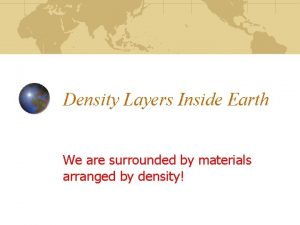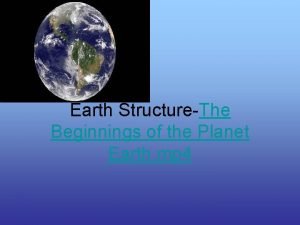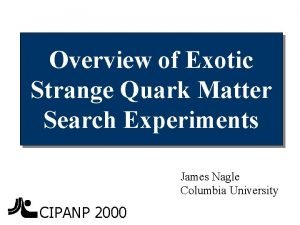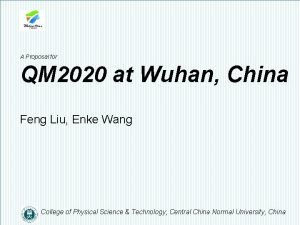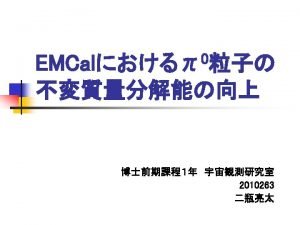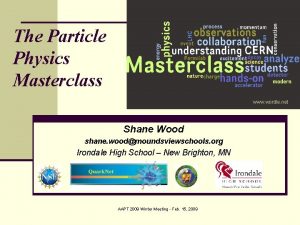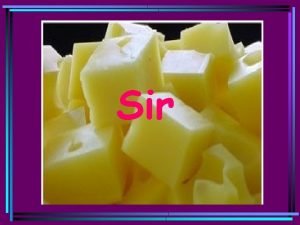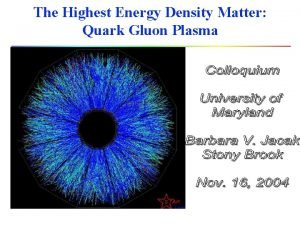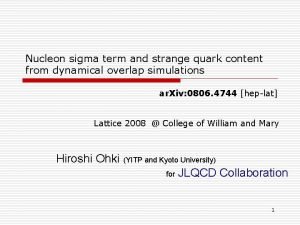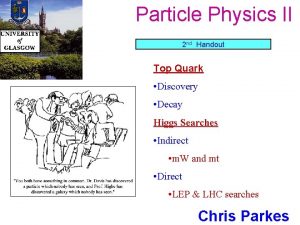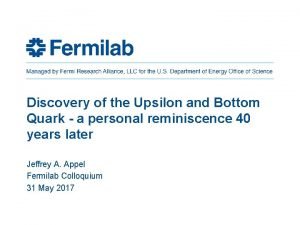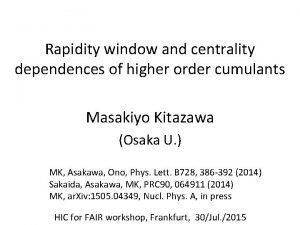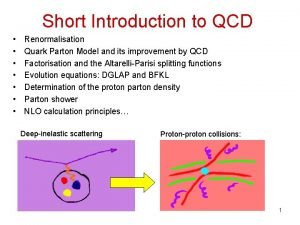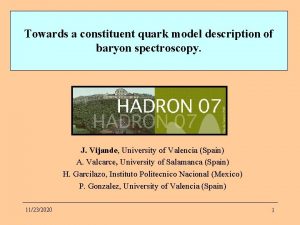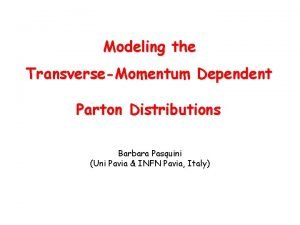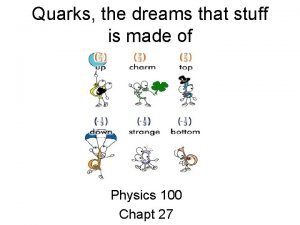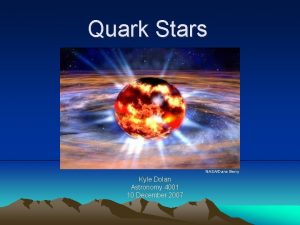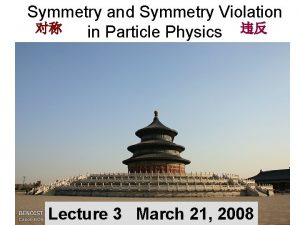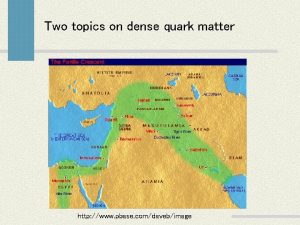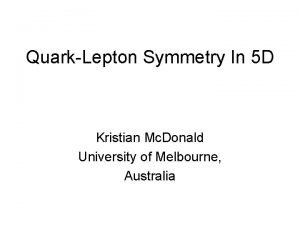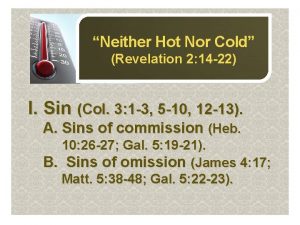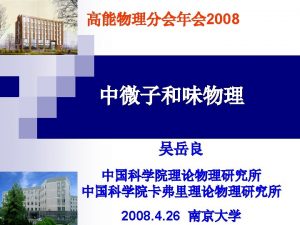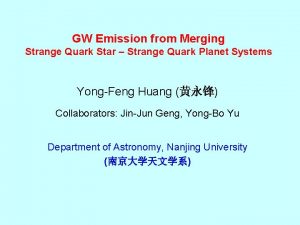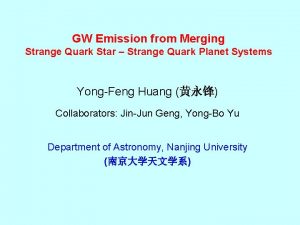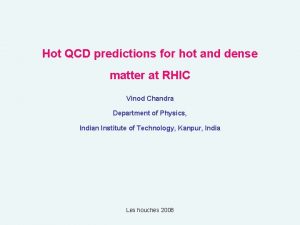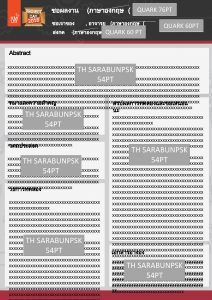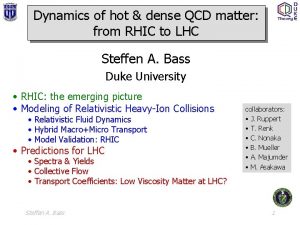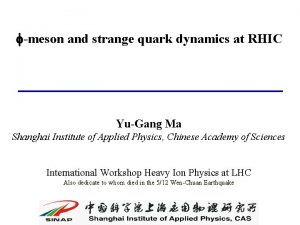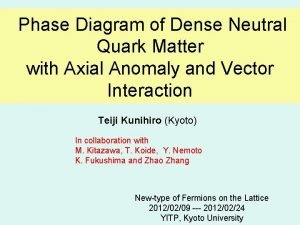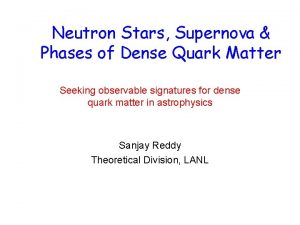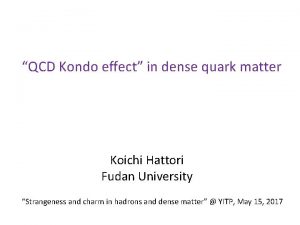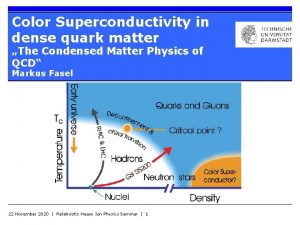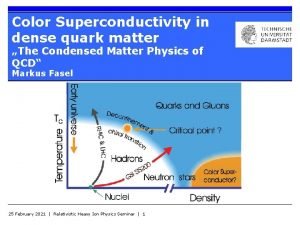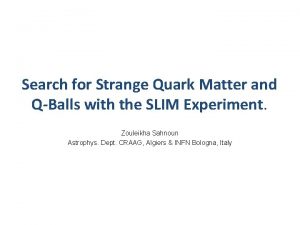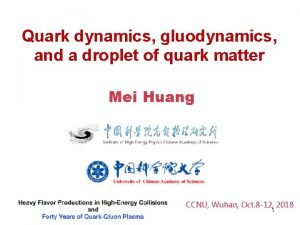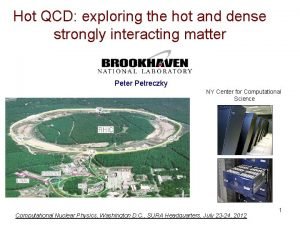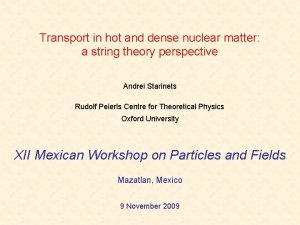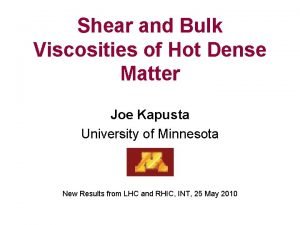Strange quark dynamics on hot dense matter under















![s/d quark ratio from primordial hyperon l s/d ratio from hyperon X 0(1530) feed-down[1]: s/d quark ratio from primordial hyperon l s/d ratio from hyperon X 0(1530) feed-down[1]:](https://slidetodoc.com/presentation_image/1a938694b7d2d0ac56976f6180cd534c/image-16.jpg)



![Dynamical model calculation (1) l A Multi-Phase Transport model[1] – Initial condition: HIJING – Dynamical model calculation (1) l A Multi-Phase Transport model[1] – Initial condition: HIJING –](https://slidetodoc.com/presentation_image/1a938694b7d2d0ac56976f6180cd534c/image-20.jpg)







- Slides: 27

Strange quark dynamics on hot dense matter under the extreme condition Yu-Gang Ma (马余刚) (SINAP) Main collaborators: Jin-Hui Chen, Guo-Liang Ma The 5 -th International Conference on Quarks and Nuclear Physics – QNP 09, IHEP@Beijing, September 21– 26, 2009

Outline l Hot dense matter under the extreme condition l Strange -quark dynamics from -meson and W- baryon — s-quark thermalization: production and W/ (PT) — s-quark collectivity: grouping behavior of elliptic flow — s-quark enhancement: -meson enhancement — s-quark un-polarization: -meson spin un-alignment — s-quark transverse momentum distribution: W/ (PT/n) — Constraints on the system evolution dynamics l Summary/outlook

Hot Dense Matter under the extreme condition @RHIC: Trigger particle (1) Away-side peak vanishes in Au-Au central collision Associated particles on away side: Hard associated particles → suppression (partonic energy loss) 4< p T (tr ig) <6 Ge V/c 4 >p. T(assoc) > 2 Ge. V/c 4 >p. T(assoc) > 0. 15 Ge. V/c Energy loss leads to redistribution of Soft associated particles → enhancement (strong jet-medium interaction) STAR coll, PRL 95 (2005)152301 3

Hot Dense Matter under the extreme condition: (2) Strong suppression of the High p. T particles Nuclear Modification Factor: nucleon-nucleon cross section leading particle hadrons <Nbinary>/sinelp+p q AA q ? If R = 1 here, nothing new going on 4

Why -meson ? K- K+ K+ K- The -meson is a clean probe from early time: ● ● ● Small s for interactions with non-strange particles[1] Relatively long-lived (41 fm/c) →decays outside the fireball Previous RHIC measurements have ruled out K+K- coalescence as f production mechanism[2] The can provide info on particle production mechanisms/medium constituents: ● The f is a meson but as heavy as L, p baryons (mass vs. particle type? ) φ φ QGP Hot Dense Matter φ KK+ [1] A. Shor, Phys. Rev. Lett. 54 (1985) 1122 [2] J. Adams et al. , Phys. Lett. B 612 (2005) 181

The STAR experiment p STAR TPC used to identify Kaon via d. E/dx in TPC gas STAR Detector p We used the high-statistics 200 Ge. V and 62. 4 Ge. V Au+Au and Cu+Cu data to measure the -meson production at STAR Event-mixing method used to estimate combinatorial background from uncorrelated K+K- pairs; p Final subtracted minv distribution fitted with Breit-Wigner + straight line. p

-meson production at RHIC <p. T>: -meson decoupled early <p. T> /K- Ur. QMD N( )/N(K-), ruled out the K+K-coalescence (red dashed line: Ur. QMD assumes K+K- coalescence mechanism for phi . Evolution in the centrality dependence: Clear change in spectral shape -- Exponential (~thermal) for central collisions -- Power law type (~ hard process) at high p. T in peripheral collisions STAR Col. Phys. Lett. B 612, (2005) 181, Phys. Rev. Lett. 99, (2007) 112301 7

-meson RCP Ømid-central collisions: RCP of meson is more consistent with that of K 0 rather than L, supporting the baryon/meson grouping behavior. The observable favors the prediction based on quark Coal/Recom model (s-sbar phi). Øperipheral collisions: The binary scaled production is very similar to that in p+p and d+Au collisions where strangeness production may be canonically suppressed. Therefore a baryon-meson scaling behavior of RCP is not expected. SINAP & LBL et al. (for STAR), PRL 99 (2007)112301

Thermalization: ’s are mostly from bulk thermal s quarks At intermediate p. T, W (sss) and (ss) should be dominated by bulk thermal quark coalescence – no jet contribution (Hwa and Yang PRC 75, 054904 (2007)) It appears that thermal quark coalescences dominate the particle production below p. T~4 Ge. V/c in central Au+Au collisions SINAP & LBL et al. (for STAR), PRL 99 (2007)112301

Collectivity of quarks: Partonic Collectivity of multi-strange particles y py x px STAR data (S. Shi et al) PHENIX π and p: nucl-ex/0604011 v 1 NCQ inspired fit: X. Dong et al. Phy. Let. B 597 (2004) 328 Partonic transport model (AMPT Model) calculations: 1. NCQ scaling works well for phi/Omega: strange quark collectivity; 2. Larger v 2 reveals in comparison with AMPT default and RQMD case. Partonic interaction is essential to reproduce larger v 2 as the data! J. H. Chen, YGM et al. , PRC 74, 064902(2006); J. X. Zuo, J. Y. Chen, X. Cai, YGM, F. Liu et al. , EPJC 55, 463(2008) 10

Strangeness enhancement We do observe strangeness enhancement: yield relative to p+p BUT -meson enhancement: -- Enhancement between net Strangeness = 1 (L, K) and 2 (X) particles -- 200 Ge. V data > 62. 4 Ge. V The above observations clearly suggest that, at these collision energies, the source of enhancement of strange hadrons is related to the formation of a dense partonic medium in high energy nucleus–nucleus collisions and cannot be alone due to canonical suppression of their production in smaller systems. SINAP & LBL et al. (for STAR), PLB 673 (2009)183

Global orbital angular momentum -Ly in unit of 105 Huge orbital angular momentum of the collisions system may lead to global quark polarization of the system Z. T. Liang (Shandong), X. N. Wang et al. , PRL 94, 102301(2005); PLB 629, 20 (2005); ar. Xiv 0710. 2943[nucl-th]. b/RA • gradient in pz-distribution along the x-direction • local orbital angular momentum impact paramet of the created parton er • quark polarized via spin-orbit? • final state hadron polarization? – hyperon polarization – vector meson spin alignment x z 12

What happen in Experiment? Lambda un-polarization |PL|<0. 02 Voloshin et al (STAR Col. ) PRC 76, 024915 (2007) Vector meson spin alignment: Deviation of ρ00 from 1/3 manifests the alignment of vector mesons; No evidence is found for the transfer of the orbital angular momentum of the colliding system to the vector meson spins. J. H. Chen (SINAP), Z. Tang (USTC), I. Selyuzhenkov (STAR), PRC 77, 061902(R) (2008) Un-polarization signal of s-quark might imply that the system created at RHIC is isotropic to the extent that, locally, there is no longer a preferred direction. It favors the QGP scenario. 13

Strange quark PT distributions at Hadronization SINAP, PRC 78 (2008)034907 Can we extract the strange quark p. T distribution from multistrange hadron data? If baryons at p. T are mostly formed from coalescence of partons at p. T/3 and mesons at p. T are mostly formed from coalescence of partons at p. T/2, then we could extract quark PT information: W and particles have no decay feed-down contribution! These particles will freeze-out earlier from the system and have small hadronic rescattering cross sections.

Strange and light quark distribution l The constitute quark p. T distributions have been extracted from the multistrange data; l The s-quark shows a flatter p. T distribution than the dquark. l The s-quark and d-quark have a similar KET distribution: partons have undergone a partonic evolution possibly described by hydrodynamics. 15
![sd quark ratio from primordial hyperon l sd ratio from hyperon X 01530 feeddown1 s/d quark ratio from primordial hyperon l s/d ratio from hyperon X 0(1530) feed-down[1]:](https://slidetodoc.com/presentation_image/1a938694b7d2d0ac56976f6180cd534c/image-16.jpg)
s/d quark ratio from primordial hyperon l s/d ratio from hyperon X 0(1530) feed-down[1]: 46%+14% l Consistent s/d ratio derived from primordial hyperon data –S feed-down: –S(1385)[2]: 26%+-5. 9%; –S 0: no data available yet –THERMUS[3]: 36% – String frag[4]: 25% [1] R. Witt, J. Phys. G 34, S 921 (2007); [2] B. I. Abelev et al. , Phys. Rev. Lett. 97, 132301 (2006); [3] S. Wheaton and J. Cleymans, J. Phys. G 31, S 1069 (2005); [4] M. Bleicher et al. , J. Phys. G 25, 1859 (1999); H. J. Drescher et al. , Phys. Rep. 350, 93 (2001). 16

s/d ratio compared with Reco. model calculation Good agreement with the data; Large exp. uncertainty; l Quark Reco. model predicted a consistent shape between s/d ratio and the hyperon ratio. 17

Fit parameter of constituent quark mass Can we put constrains on the constitute quark mass parameter ? 18

Constraints on the system evolution dynamics l Theoretical model for particle production at RHIC typically involve initial conditions, partonic evolutions, hadronization and hadronic evolutions. l Theoretical uncertainties due to hadronization scheme and hadronic evolution are major issues for quantitative description of properties of QCD medium created at RHIC. eg. , the hadronic evolution process have been added to the hydrodynamic models as an afterburner and have been shown to significantly alter the spectra shapes of ordinary hadrons[1]. [1] T. Hirano et al. , Phys. Rev. C 77, 044909 (2008) Can our derived quark distributions, representing a cumulative effect from initial conditions through partonic evolution, be used to determine the final-state hadron momentum distribution? 19
![Dynamical model calculation 1 l A MultiPhase Transport model1 Initial condition HIJING Dynamical model calculation (1) l A Multi-Phase Transport model[1] – Initial condition: HIJING –](https://slidetodoc.com/presentation_image/1a938694b7d2d0ac56976f6180cd534c/image-20.jpg)
Dynamical model calculation (1) l A Multi-Phase Transport model[1] – Initial condition: HIJING – Partonic evolution: ZPC – Hadronization: coalescence – Hadronic evolution: ART [1] Z. W. Lin et al. , Phys. Rev. C 72, 064901 (2005) l Original version failed to reproduce the spectra data: – Insufficiency parton cascading cross sections in the ZPC model where only p. QCD processes have been included? – Wrong choice of hadronization scheme? 20

Dynamical model calculation (2) l Modified version: – Tuned the initial parton p. T distribution inherited from HIJING string melting empirically, (v. T 0, Tth 0); – Requirement: the tuned distributions after parton cascade match our derived s/d quark dis; – Coalescence scheme: two nearest (in coordinate space) quarks meson while three nearest quarks baryon. It can faithfully reproduce the data at intermediate p. T. An essential ingredient in Reco. /Coa. model calculation: the distribution of effective constituent quarks that readily turn into hadron. 21

Summary Ø N( )/N(K) vs. Npart rules out the K+K- coalescence as a dominant channel for production at RHIC; Ø N(W)/N( ) vs. p. T favors the model prediction that s are made via thermalied squarks coalescence at RHIC; Ø N(W)/N( ) and N(X)/N( ) vs. p. T/nq indicate the s-quark and d-quark have a similar KET distribution: partons have undergone a partonic evolution possibly described by hydrodynamics; the distribution of effective constituent quarks can reproduce the reasonable hyperon Pt distribution. Ø v 2( ) vs. p. T concludes that the partonic collectivity has been formed at RHIC; Ø Un-polarization signal of s-quark might imply that the system created at RHIC is isotropic to the extent that, locally, there is no longer a preferred direction. Again, favors the QGP scenario. Since mesons are made via coalescence of seemingly thermalized s quarks in central Au+Au collisions, the observations imply hot and dense matter with partonic collectivity has been formed at RHIC.

All 120 TOF trays are installed at STAR and data will be taken in next RHIC runs PID information for > 95% of kaons and protons in the STAR acceptance Clean e± ID down to 0. 2 Ge. V/c STAR-China Collaboration plan: 120 trays of MRPC modules which leverage l /K separation to 1. 6 Ge. V/c – 0. 7 for TPC alone et al) MRPC development at CERN (Crispin Williams l ( +K)/p to p = 3 Ge. V/c Development of HPTDC Chip – 1. 2 for TPC alone l Clean from electron ID down STAR-MRPC TOFs are contributed the China-STAR to 0. 2 Ge. V group Fully complete in time for run 10 (fall 2009) TOF+TPC : one kaon from φ identified by TPC, the other by TOF TPC+TPC : the 2 kaons from φ identified using only TPC 23

RHIC low energy scan: the breaking of NCQ scaling of elliptic flow? J. Tian, J. H. Chen, Y. G. Ma et. al. , Phys. Rev. C 79, 067901 (2009) Violation of the NCQ scaling for the identified-particle elliptic flow may indicate the hadronic dominant phase is coming. Y. G. Ma 24

Di-hadron correlation in the AMPT model: YGM, JPG 32(2006)S 373, SQM 06 Black: trigged by orΩ; Blue: trigged by any hadron p p Away side: Phi/Omega-trigged correlation functions are narrower than the hadrons-trigged correlation function it is consistent with the scenario of earlier freeze-out of phi/omega production 25

Many Thanks for STAR collaborators, especially for Jinhui Chen, Guoliang Ma, Xiangzhou Cai, Huanzhong Huang, Nu Xu et al.

Creation of the Hot Dense Matter under the extreme condition at RHIC heavy ion collisions Away-side peak vanishes in Au-Au central collision@200 Ge. V/c dense matter Strong suppression of the High Pt meson Hot dense matter RHIC creates hot and dense matter, parton loss energy when RHIC white paper: Nucl. Phys. A 757 traverse the medium. 27
 The earth's layers foldable
The earth's layers foldable Which layer is the least dense
Which layer is the least dense Earth's layers most dense to least dense
Earth's layers most dense to least dense Quarks
Quarks Quark matter 2022
Quark matter 2022 Quark gluon plasma
Quark gluon plasma Physics wordle
Physics wordle Sirutka u prahu vindija
Sirutka u prahu vindija Quark gluon
Quark gluon Sigma quark composition
Sigma quark composition Top quark decay
Top quark decay Quark names
Quark names Quark gluon plasma
Quark gluon plasma Quark parton model
Quark parton model Constituent quark model
Constituent quark model Quark names
Quark names Quark model
Quark model Quark types
Quark types Quark astronomy
Quark astronomy A charm quark has a charge of approximately
A charm quark has a charge of approximately Quark gluon
Quark gluon Quark lepton symmetry
Quark lepton symmetry Perbedaan hot lava dan hot lava volcano
Perbedaan hot lava dan hot lava volcano Hot nor
Hot nor White hot vs red hot temperature
White hot vs red hot temperature Hot working and cold working
Hot working and cold working Energy naturally flows from warmer matter to cooler matter
Energy naturally flows from warmer matter to cooler matter Composition of matter section 1
Composition of matter section 1
